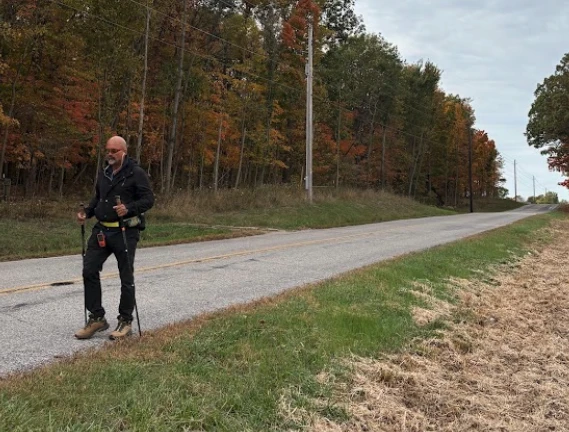

Father Gary Graf walks down a rural road during his trek across America in support of immigrants on Friday, Oct. 17, 2025. / Credit: Photo courtesy of Father Gary Graf
CNA Staff, Nov 24, 2025 / 06:00 am (CNA).
After a month and a half of walking an average of 17 miles a day, 67-year-old Father Gary Graf said he is starting to get “a little pain in one shin,” but his broken ribs are “getting much better.”
On Oct. 6, Graf, a Catholic priest from Chicago, began a journey on foot from Pope Leo XIV’s childhood home in Dolton, Illinois, to New York City to bring attention to the plight of immigrants amid the sometimes “inhumane” ways the Trump administration is treating them during its immigration enforcement actions.
He hopes to arrive at the Statue of Liberty on Ellis Island, where his own great-grandparents entered the country as immigrants, by Dec. 2.

A few weeks ago, when visiting a parish in Indiana, he was invited to ride a horse. He fell off as it galloped and broke several ribs, which led him to take one day off to recover. That day, friends walked in his stead.
Graf, the pastor of the mostly Hispanic Our Lady of the Heights Catholic Church in Chicago Heights and a longtime member of Priests for Justice for Immigrants, has committed his life to helping immigrants. Ordained in 1984, he spent five years as a priest in Mexico serving a people “with whom I fell deeply in love.”
He told CNA that after initially feeling helpless watching the raids taking place against his beloved community in his hometown of Chicago, he “felt a call that was directly from above” to start walking.

Within weeks, he was on the road. He first spoke to an old friend about his idea, who immediately connected him with Lauren Foley, the head of a public relations firm. She “immediately embraced the idea,” and between her help and that of some “young people who understand social media,” a website as well as social media accounts were set up to chronicle his journey and to share the stories of immigrant families.
Of the immigrants on whose behalf he is walking, Graf said: “I look to help people who get up every single morning to work and raise their families. If I can do this small gesture on their behalf, what a blessing it is, what a privilege.”
Asked about the most profound insight he has gained thus far, Graf said his long days walking through the wide expanse of rural America have helped him understand better the ways of people who did not grow up in a multicultural city like he did.
“We have to reverently appreciate and try to connect with those whose lives we’re passing through,” he said.
As he has spoken with people in diners along his path, Graf has developed “a greater sensitivity,” discovering that “there’s not a lot of animosity against the immigrant.”
Many of the people he has met simply do not know any, he said.
Along the way, he has also experienced unity with Christians from other denominations, as well as with those without religious faith, who all care about the humane treatment of human beings.
“I have seen so much goodness,” he said. “This has brought so many of us together: people from many different faith traditions, or none. This is an opportunity given to us.”
During his quiet walks through rural farmland, he has marveled at the amount of labor it took to build the many roads, bridges, and overpasses he has seen.
“I’m sure the hands of many immigrants helped build these things,” he reflected.
Graf said he is delighted that both the U.S. Conference of Catholic Bishops and Pope Leo XIV addressed the immigration enforcement situation in the past week.
The U.S. bishops issued a special message during its Fall Plenary Assembly two weeks ago, calling for “a meaningful reform of our nation’s immigration laws and procedures.” The bishops argued that “human dignity and national security are not in conflict. Both are possible if people of goodwill work together.”
The pope echoed the bishops’ message. On Nov. 18, he acknowledged to reporters that “every country has a right to determine who and how and when people enter.”
“But when people are living good lives, and many of them for 10, 15, 20 years, to treat them in a way that is extremely disrespectful, to say the least — and there’s been some violence, unfortunately — I think that the bishops have been very clear in what they said.”
“I think that I would just invite all people in the United States to listen to them,” the pope said.
“Both the pope and the bishops used the word ‘indiscriminate’ to talk about the way people are being singled out and aggressively having their wrists zip-tied behind their backs as their faces are pushed to the ground in front of their children,” Graf said.
“It is indeed indiscriminate. This reflects dishonesty on the administration’s part,” he said. “They said they were going after the ‘worst of the worst,’ criminals, but this isn’t the case, at least in Chicago. They’re grabbing people first and asking questions later.”
“The violent way many of these people are being treated is amoral and un-American,” he said.
Like the pope and the American bishops, Graf said he hopes the federal government will establish a more humane immigration system that respects the dignity of immigrants as well as the rule of law and the country’s right to regulate its borders.
“I am not a politician,” he said. “My job is to mediate, to speak up, in God’s name, in the united name of the Church. But can we look for a way for those who are fulfilling their responsibilities; for them to one day receive the rights of citizens?”
The priest, who appeared on “EWTN News Nightly” in October, said he has been “impressed by the media” and is grateful his message is being spread.
“If we don’t hear the whole truth, the incredible ignorance and darkness we live in can paralyze us, and keep us from doing what we ought to do,” he said.
Read More![How pregnancy centers help women: Centers provide $450 million in value, report finds #Catholic
Jessica Williams and her 3-year-old daughter were helped by First Choice Pregnancy Services in Las Vegas. / Credit: Photo courtesy of Susan B. Anthony Pro-Life America
CNA Staff, Nov 17, 2025 / 16:11 pm (CNA).
When Jessica Williams became pregnant with another man’s child while she and her husband were separated, her husband pressured her to abort the child.As soon as she took the first abortion pill, mifepristone, she regretted it. “As a nurse, the reality of what I had done had hit me hard,” said Williams, who was nine weeks pregnant at the time. “Here I was working to save lives and about to take one of my own child’s lives.” But as a nurse, Williams knew that in spite of the pill cutting off the progesterone supply to her child, the baby might still be alive. She hadn’t yet taken the second pill, misoprostol, which would expel the child from her body. When she found a pregnancy center, First Choice Pregnancy Services in Las Vegas, staff immediately brought her in for an ultrasound.“They provided a free ultrasound, and that moment changed everything,” she said. Her baby was still alive.First Choice helped her through the abortion pill reversal process, a practice to reverse the effects of mifepristone soon after the woman takes the first abortion pill. Now, her daughter is a “healthy” and “thriving” 3-year-old, Williams said when she shared her story at a Nov. 17 online press conference.Williams is one of many women who have received help from pregnancy resource centers. Pregnancy centers across the U.S. “provided over $452 million in total medical care, support and education services, and material goods in 2024,” according to a Nov. 17 report by the Charlotte Lozier Institute. Pregnancy centers saw a total of 1 million new patients last year, “which is the equivalent of each center serving a new client every day in 2024,” Karen Czarnecki, the head of Charlotte Lozier Institute, said during the press conference. During the press conference, Marjorie Dannenfelser, head of Susan B. Anthony Pro-Life America, called pregnancy centers the “beating heart” of pro-life movement. Pregnancy centers, Dannenfelser said, “are going to the roots of the problem” by providing support for mothers across the board, whether they are struggling with addiction, domestic abuse, homelessness, completing school, or any other challenge. Report debunks false claims about pregnancy centers Dannenfelser noted there are some claims “often unchecked in the media” that call pregnancy centers “fake clinics” or say they “don’t have licensed medical staff.”“This is flat-out false,” Dannenfelser said. “Eight in 10 centers are providing free or low-cost medical services, staffed by over 10,000 medical professionals.” More than 80% of these centers provide ultrasound services, according to the report. Many of the centers also provide STD and STI testing and treatment, as well as abortion pill reversal, like in Williams’ experience. The report also found a 98% satisfaction rate among their clients — something Williams attested to.“They greeted me gently and were nonjudgmental,” Williams said of the staff and volunteers at the pregnancy clinic she went to. “They provided a safe, calm space for me, emotionally, spiritually.”“They gave me information and education without pushing me in any direction,” she continued. “They simply supported me in whatever path I chose.”More than three years later, Williams still keeps up with the women at the clinic.“I’m meeting with these ladies every month still,” Williams said. “They’re just a phone call, a text away, anything I need. I mean, we’re just almost becoming a family now.” Pregnancy centers also provide material, educational, and emotional support. For instance, 92% of centers offer material items to women in need. On average, each pregnancy center distributed six-packs of diapers and five baby outfits every day, according to the report. First Choice “provided diapers, material support, emotional and spiritual support groups, parenting resources, community connections, and just so much practical help in general,” Williams said. “It was a level of compassion that carried me through my entire pregnancy.” Offering material support is a growing effort in the pro-life movement. At pregnancy centers, material support has grown by more than 300% from 2019 to 2024.Many pregnancy centers also offer a variety of other resources, including childbirth classes, breastfeeding consultations, and outreach to victims of human trafficking. “Even right now, they’re doing a monthly get-together — we get to network with other mamas,” Williams said. “We’re [able] to access any resources.” The majority of pregnancy centers also help support women who are recovering from abortions.Williams said the women at the clinic “understood the pressure and fear” she was under to abort. Even after the reversal, her husband drove her to an abortion clinic when she was 16 weeks pregnant “to finish the job,” she said. “The clinic was on the same exact street [where] I saved my baby,” she said. “I couldn’t do it and demanded he take me home. I now know that the strategic location has also saved many other babies.” “They created a safe place for me to heal and feel supported,” she said of the clinic.](https://unitedyam.com/wp-content/uploads/2025/11/how-pregnancy-centers-help-women-centers-provide-450-million-in-value-report-finds-catholic-jessica-williams-and-her-3-year-old-daughter-were-helped-by-first-choice-pregnancy-services-in-las-v.webp)

![CNA explains: Why does the Catholic Church prohibit ‘gay marriage’? #Catholic
null / Credit: Daniel Jedzura/Shutterstock
CNA Staff, Nov 17, 2025 / 06:00 am (CNA).
Slightly over 10 years after it redefined marriage to include same-sex couples, the U.S. Supreme Court on Nov. 10 declined to revisit that controversial decision, upholding at least for now its ruling in Obergefell v. Hodges that made “gay marriage” the law of the land.A decade after that ruling, nearly a million same-sex couples in the U.S. are participating in what the law now defines as marriage. Yet the Catholic Church has continued to affirm the definition of marriage as being exclusively a union between a man and a woman. That has been the prevailing definition of marriage around the world for at least about 5,000 years of human history, though many societies have allowed polygamy, or multiple spouses, in various forms. The same-sex variant of marriage, meanwhile, only became accepted in recent decades. The Church has held since its beginning that marriage is strictly between one man and one woman. The Catechism of the Catholic Church directs that marriage occurs when “a man and a woman establish between themselves a partnership of the whole of life.” It is “by its nature ordered toward the good of the spouses and the procreation and education of offspring.”Church Fathers and theologians from the earliest days of Catholicism have consistently upheld that marriage is meant to be a lifelong, permanent union between one man and one woman, with St. Augustine explicitly naming “offspring” as one of the blessings of marriage, along with “fidelity” and “the sacramental bond.”Gay marriage a ‘misnomer’ by Church teachingJohn Grabowski, a professor of moral theology at The Catholic University of America, told CNA that marriage in the Catholic Church’s teaching is based on “unity, indissolubility, and [is ordered] toward life,” or the begetting of children.“Those criteria can only be met in a union between a man and a woman,” he said. “They cannot be met in a union between two men and two women. ‘Gay marriage’ is thus a misnomer in the Church’s understanding.”The Supreme Court’s redefinition of marriage, Grabowski argued, was an act of “judicial fiat” rather than a recognition of what marriage actually is. He said the high court was functioning more as a “cultural barometer” reflecting an erroneous shift in perception on what marriage is.“It would be similar to if the court passed a rule saying we could call a square a circle,” he said. “It’s just not based on the reality of the natural world.”The Obergefell ruling came after years of LGBT activist efforts to redefine marriage both within individual states and at the federal level. Advocates had argued that there was no meaningful reason to restrict marriage to opposite-sex couples and that to do so constituted discrimination. Many critics have claimed that the Church’s broader teaching on marriage actually left the door open for same-sex couples to marry — for instance, they argued, by allowing opposite-sex couples to marry even if one or both of the spouses are infertile, the Church implicitly divorces biological childbearing from marriage itself. Grabowski acknowledged that the Church does allow infertile couples to get married (and to stay married if infertility occurs at a later date). But he pointed out that the Church does in fact prohibit marriage for those who are impotent, or constitutionally incapable of intercourse. The key point for the Church, he said, is what St. John Paul II called the “spousal meaning of the body.” The late pope argued that men and women “exist in the relationship of the reciprocal gift of self,” ordered to the communion of “one flesh” of which the Bible speaks in Genesis. The Church’s teaching, Grabowski said, “is based on the natural law. It tells us that the way God designed us is for the good of our flourishing, both as individuals and as the good of society.”Though marriage advocates have continued to criticize the Supreme Court’s decision over the past decade, others have at times suggested a pivot away from directly challenging it at the legal level. In 2017, for instance, Winona-Rochester, Minnesota, Bishop Robert Barron affirmed his opposition to gay marriage but questioned “the prudence and wisdom” of attempting to legislatively outlaw it at that time. The bishop suggested instead that “personal witness and education” were better tools for the current political climate.Grabowski acknowledged that one “could say, realistically, the ship has sailed and the political question is dead.”“But that’s a political judgment,” he said. Catholics should not lose sight of the goal to reestablish correct laws on marriage, he argued.“In terms of something to hope for, pray for, and to the degree that we’re able to, work for it — that’s something Catholics should aspire to.”](https://unitedyam.com/wp-content/uploads/2025/11/cna-explains-why-does-the-catholic-church-prohibit-gay-marriage-catholic-null-credit-daniel-jedzura-shutterstockcna-staff-nov-17-2025-0600-am-cna-slightly-over-10.webp)

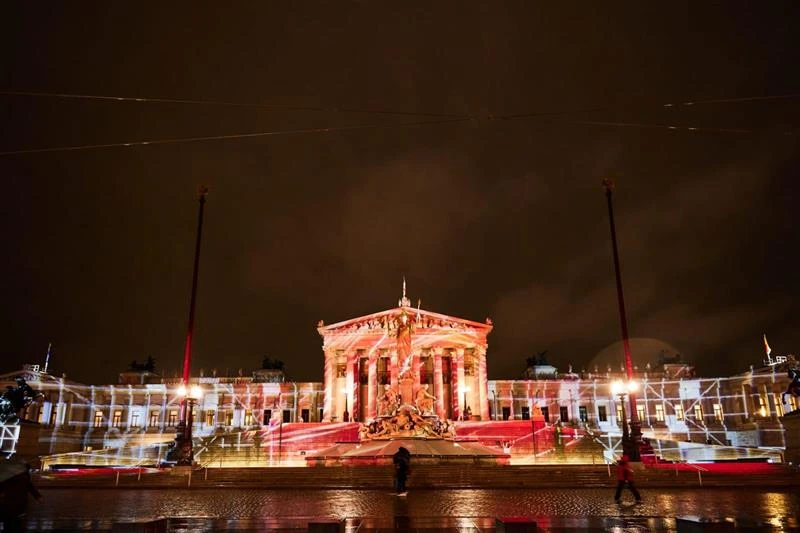

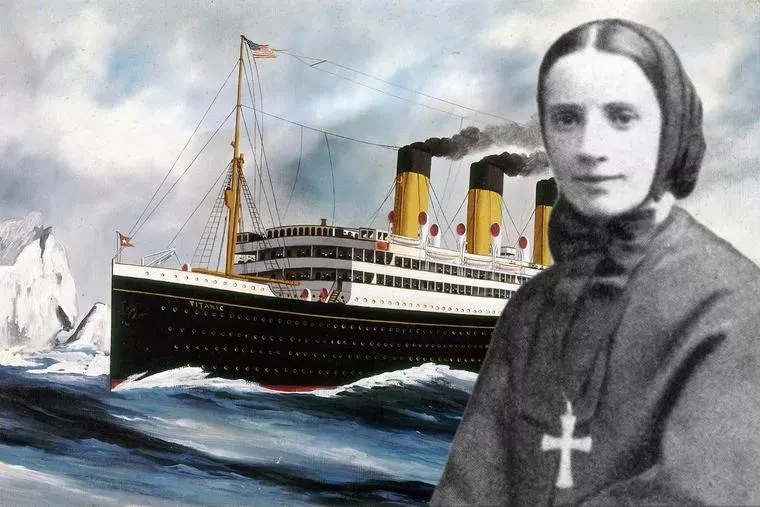

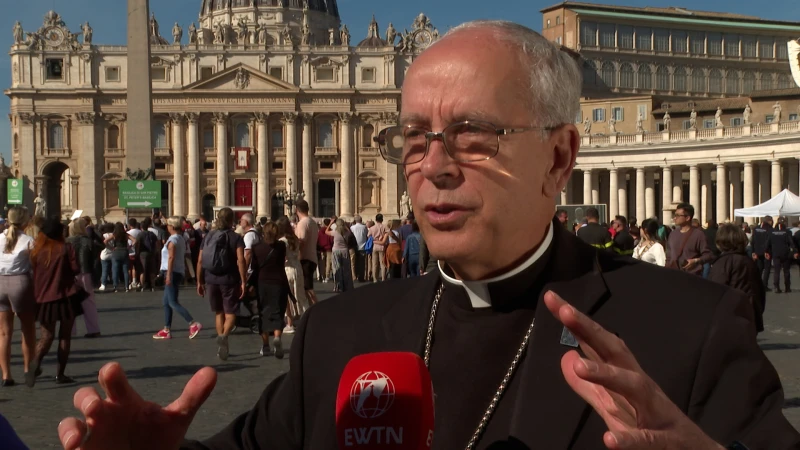

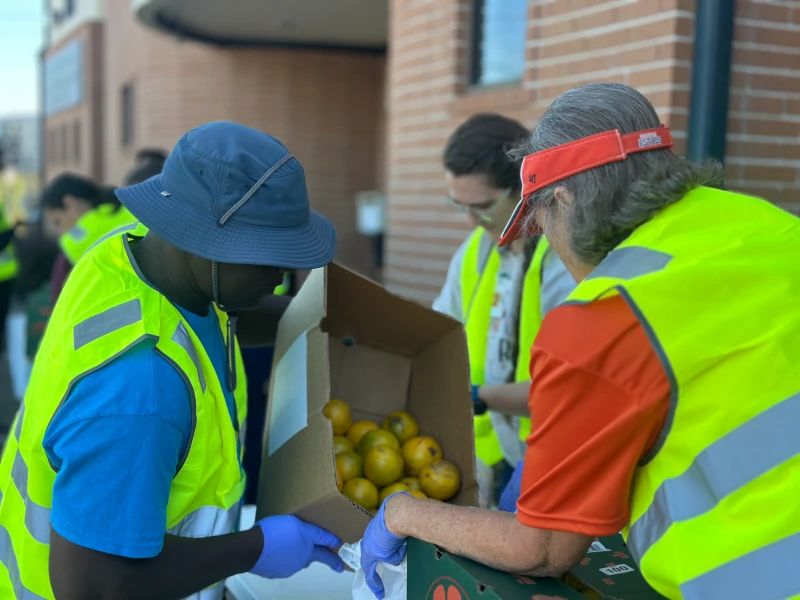






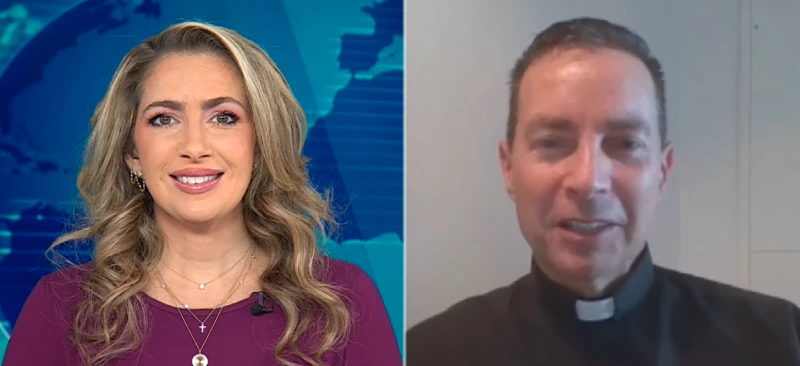

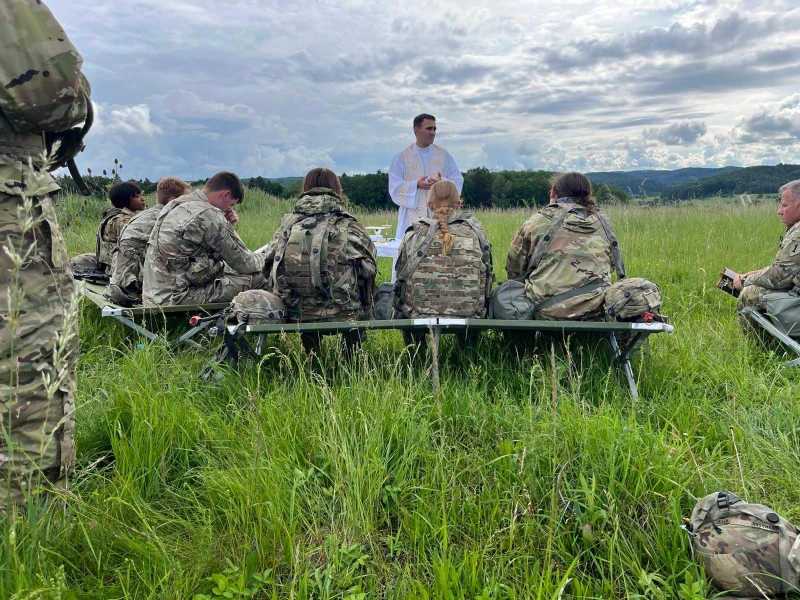







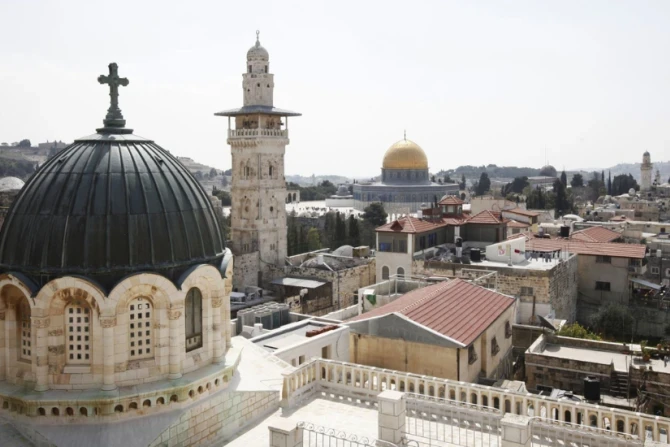

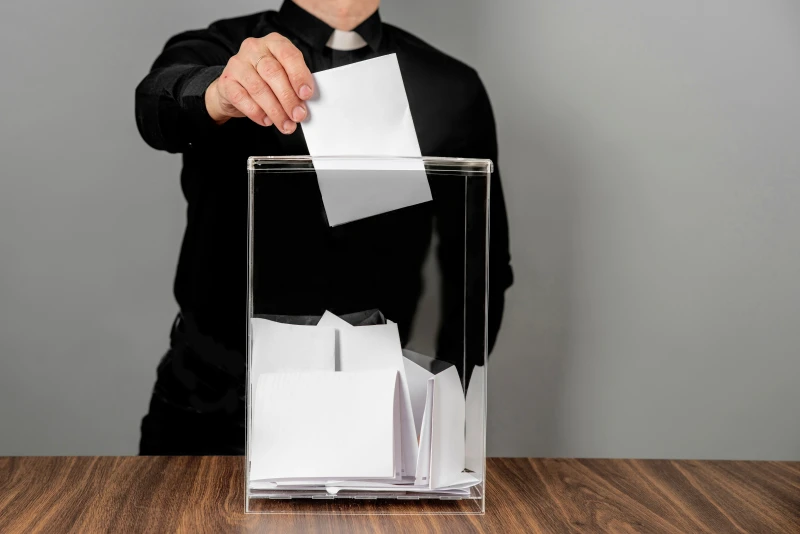

![Israelis, Gazan Christians, Catholics in U.S. weigh in on historic peace deal #Catholic
Daniel Ayalon, former Israeli ambassador to the U.S. and former foreign policy adviser to Prime Minister Benjamin Netanyahu, speaks with “EWTN News Nightly” anchor Veronica Dudo on Oct. 10, 2025. / Credit: “EWTN News Nightly”
Washington, D.C. Newsroom, Oct 11, 2025 / 08:00 am (CNA).
Former Israeli government officials, representatives for the Latin Patriarchate of Jerusalem, and Catholic advocates for Israel in the U.S. spoke with EWTN News this week following the historic peace deal brokered by the Trump administration between Israel and Hamas. News of the peace agreement came as “a joy for the entire population of Gaza, for the families of the hostages, and for our parish, our little parish there in Gaza,” according to Farid Jabran, the public and government affairs adviser for the Latin Patriarchate of Jerusalem.In an Oct. 10 interview with “EWTN News Nightly,” Jabran noted there is still an air of “expectation” as the region waits to “see what happens.”Jabran revealed that Latin Patriarch Cardinal Pierbattista Pizzaballa had spoken to the pastor of Gaza’s only Catholic Church, Father Gabriel Romanelli. “They are all very happy that they are not hearing more bombings,” Jabran said of the Gazan parish community. “They expect a better future, but still they wait to see what is going to happen … They’re all waiting to see what happens after the release of the hostages.” “The Catholic Church, as the patriarch, as the pope, as many said, will give anything in its power to to offer assistance, to offer good services when it’s asked to do so,” said Jabran, noting that the Latin Patriarchate has “big plans for Gaza,” including the construction of a new hospital in the southern region of the enclave. “We’ll have more details on that that will be supported by the Italian Conference of Catholic Bishops and the Latin Patriarchate,” he revealed, adding: “We are planning to create field hospitals in several places and to work on schools and education for the children, not only for the Christian community [but] for everyone.”Breaking down the peace deal In an Oct. 10 appearance on “EWTN News Nightly,” Daniel Ayalon, former Israeli ambassador to the U.S. and former foreign policy adviser to Prime Minister Benjamin Netanyahu, shared how the historic peace deal brokered by the Trump administration will play out in the coming days. Though both Israel and Hamas signed on to the first phase of the peace plan set out by the Trump administration on Wednesday, reports of ongoing bombardment from the IDF in northern Gaza was reported on Friday morning. Avalon explained that “there was a threat that the IDF depicted, and they had to take care of it.” “We have enough experience with Hamas that even though they agree on a ceasefire, they continue their aggression,” he told “EWTN News Nightly” anchor Veronica Dudo. “But we adhere, or Israel adheres to the agreement and to the ceasefire terms … We started right on time, and we are now back off the former position, and hopefully we will see our hostages within the next 72 hours.” President Donald Trump announced on Truth Social on Wednesday that both parties had agreed to the first phase of his 20-point peace plan for the Middle East, in which he noted: “ALL of the hostages will be released very soon, and Israel will withdraw their troops to an agreed-upon line as the first steps toward a strong, durable, and everlasting peace.”“I think that we should all acknowledge the leadership and the negotiation capabilities of President Trump and his team,” Ayalon said. “I believe that they found the right moment to really bring together an assembly of protagonists in the region that could really be instrumental, namely, Turkey, Qatar, and Egypt, that put a lot of pressure on Hamas that was not there before.” Given that the first phase goes according to plan, Ayalon said, Israel will release its Palestinian prisoners, and IDF troops will continue to withdraw, allowing Gazans to return to their homes. After which, he said, comes the precarious task of disarming Hamas, which will include dismantling its vast network of tunnels. This task, he predicted, could take several months. “I think the people of Gaza deserve this,” Ayalon reflected. “After these two horrendous years … they were actually held hostage by Hamas, which used them as cannon fodder or as human shields.” The former ambassador further expressed hope that Gazans ensure “no more terror organizations will grow there to a monstrous dimension, as we did with Hamas.”Looking ahead, Ayalon expressed hope for a broader normalization of relations between Israel and its Arab neighbors, such as Saudi Arabia and others, as well as other major Islamic countries such as Indonesia or Pakistan, to take place alongside reconstruction. He also floated the start of “a political process with the Palestinians,” noting Hamas will no longer govern the enclave. “It probably will be the Palestinian Authority,” he said, noting that under the agreement the governing body is mandated to promote peaceful coexistence and to “do away with terror” and indoctrination in its schools. “Then we can talk about real peace between Israel and the Palestinians, which may be a cornerstone of a much broader peace with the region,” he said, adding: “And we all deserve it — the world deserves it, and I think it will be to the benefit and the prosperity of all here.”Remembering Oct. 7On the two-year anniversary of the Oct. 7, 2023, Hamas attacks on Israel, Philos Catholic Director Simone Rizkallah told CNA: “This is not a day to discuss U.S. foreign policy or to analyze political dynamics.” Even with the Trump administration’s efforts in the background to make a peace deal between the Hamas terrorist group and Israel, Rizkallah emphasized, “Oct. 7 is a day to live out the beatitude ‘Blessed are they who mourn.’” Philos Catholic is an arm of the U.S-based nonprofit organization, the Philos Project, which works to foster Catholic-Jewish relations. Over 1,200 Israelis and 22 Americans were confirmed killed, and thousands more wounded in the wake of Hamas’ large-scale surprise attack on Israel. An additional 251 were taken hostage into the Gaza Strip.“We mourn with the Jewish people and with Israel as if we are mourning for our own selves — because, in truth, we are,” she said. “To stand with our Jewish brothers and sisters today is not a political act, and it is certainly not a partisan one. The Church is not a political entity. This is about faith and the culture that faith gives birth to.”According to Rizkhallah: “To speak up and stand with our Jewish friends is not sentimental — it is an act of spiritual realism and solidarity with our own people in the faith.” To do so, she continued, is not a partisan act but a “part of orthodox Catholic theology, rooted in the heart of the Church’s self-understanding.”Catholics, she urged, should “incarnate this love by showing up in the flesh” for their Jewish friends and neighbors. “Call your Jewish friends,” she said. “Reach out to your local synagogue or Jewish community center. Drop off white roses in the wake of antisemitic attacks — a symbol of Christian resistance to hatred, inspired by the White Rose movement that opposed Nazi Germany.”Philos Catholic will host an event commemorating the 60th anniversary of Nostra Aetate this year at the Saint John Paul II National Shrine in Washington, D.C., which will be available to attend both in person and virtually.](https://unitedyam.com/wp-content/uploads/2025/10/israelis-gazan-christians-catholics-in-u-s-weigh-in-on-historic-peace-deal-catholic-daniel-ayalon-former-israeli-ambassador-to-the-u-s-and-former-foreign-policy-adviser-to-prime-minister-ben.webp)







